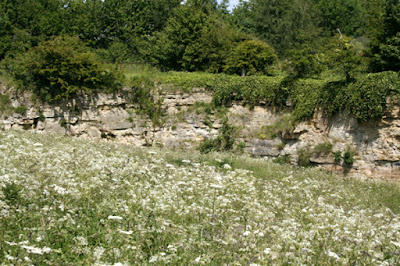 |
| The SSSI at South Elmsall Quarry |
South
Elmsall Quarry is of national importance
because it provides an unusually complete section through a patch-reef in the
Wetherby Member of the Cycle EZ1 Cadeby Formation and the report for the
Geological Conservation Review
is pitched at geologists with a high level of knowledge of the Permian rocks in
England.
 |
| The South Elmsall Quarry Site of Special Scientific Interest |
Arriving
at the site, there is a layby that will accommodate a few cars but the display
board, which introduces you to the geology, is somewhat obscured by the
surrounding vegetation and has been damaged by high power weapons – perhaps indicating
that not everyone is interested in conserving their national heritage assets.
 |
| Stromatolites |
I
had previously seen images on Google that showed extensive areas of managed
green space but, before I could get to see the rock face, I had to wade through
the various plants that were growing there in the middle of June; although the
paths weren’t totally overgrown, I did graze my boots on a few stones that I
couldn’t see, whilst exploring this site.
 |
| A general view of South Elmsall Quarry |
In
South Yorkshire, similar reefs form irregular sack like masses that strongly
contrast with the surrounding well bedded limestone and, at most sites that I
have seen, it is possible to see some of the palaeontology and petrology in
quite fine detail but, at South Elmsall Quarry, these have largely been
obscured by diagenetic processes.
 |
| A detail of the stromatolites at South Elmsall Quarry |
Although I can think
of better locations at which to demonstrate the features of bryozoan reefs,
close up, the panoramic views of the stromatolites make this place quite spectacular and it would definitely be on the list of places to visit on a field study tour.